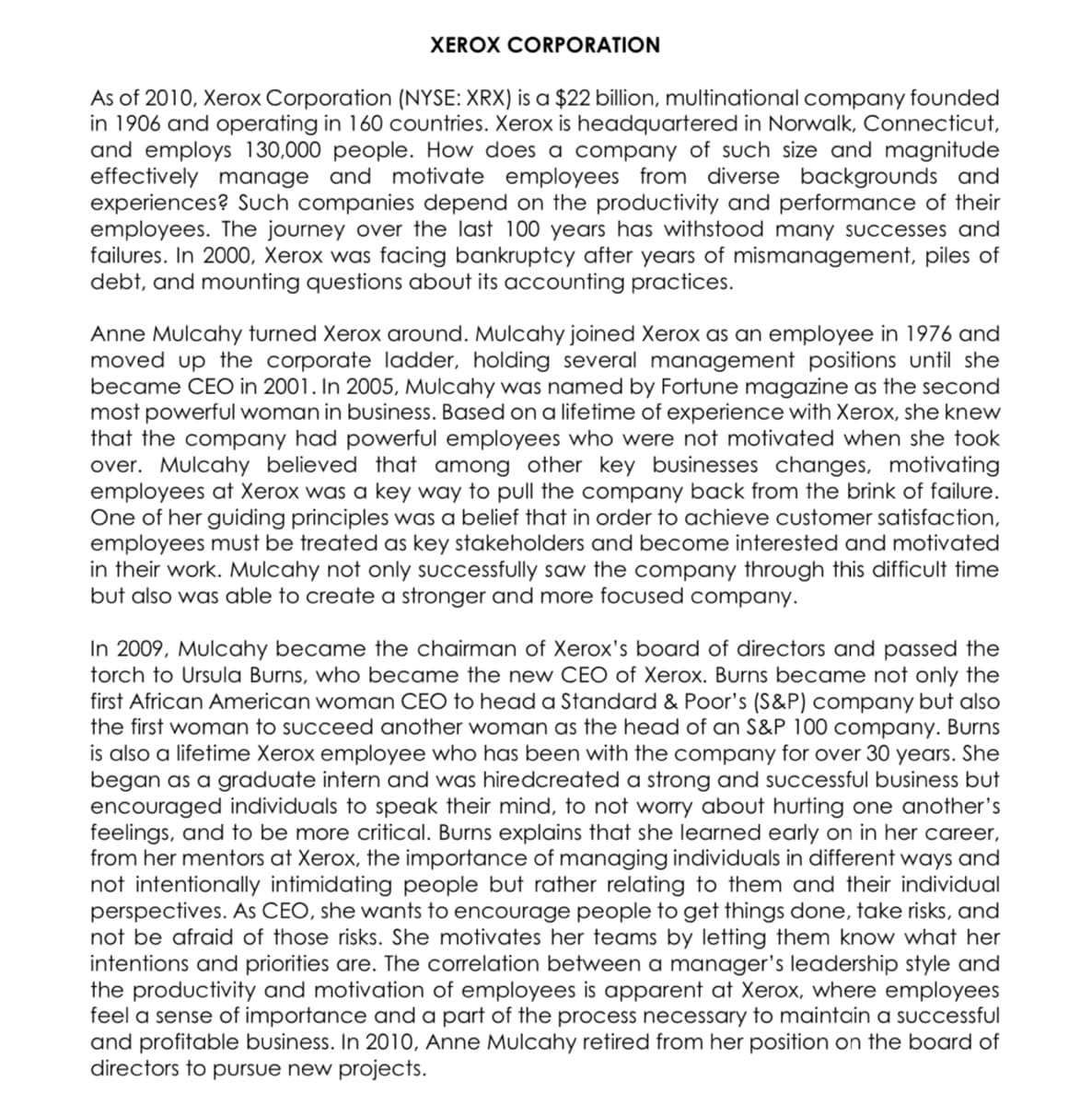XEROX CORPORATION As of 2010, Xerox Corporation (NYSE: XRX) is a $22 billion, multinational company founded in 1906 and operating in 160 countries. Xerox is headquartered in Norwalk, Connecticut, and employs 130,000 people. How does a company of such size and magnitude effectively manage and motivate employees from diverse backgrounds and experiences? Such companies depend on the productivity and performance of their employees. The journey over the last 100 years has withstood many successes and failures. In 2000, Xerox was facing bankruptcy after years of mismanagement, piles of debt, and mounting questions about its accounting practices. Anne Mulcahy turned Xerox around. Mulcahy joined Xerox as an employee in 1976 and moved up the corporate ladder, holding several management positions until she became CEO in 2001. In 2005, Mulcahy was named by Fortune magazine as the second most powerful woman in business. Based on a lifetime of experience with Xerox, she knew that the company had powerful employees who were not motivated when she took over. Mulcahy believed that among other key businesses changes, motivating employees at Xerox was a key way to pull the company back from the brink of failure. One of her guiding principles was a belief that in order to achieve customer satisfaction, employees must be treated as key stakeholders and become interested and motivated in their work. Mulcahy not only successfully saw the company through this difficult time but also was able to create a stronger and more focused company. In 2009, Mulcahy became the chairman of Xerox's board of directors and passed the torch to Ursula Burns, who became the new CEO of Xerox. Burns became not only the first African American woman CEO to head a Standard & Poor's (S&P) company but also the first woman to succeed another woman as the head of an S&P 100 company. Burns is also a lifetime Xerox employee who has been with the company for over 30 years. She began as a graduate intern and was hiredcreated a strong and successful business but encouraged individuals to speak their mind, to not worry about hurting one another's feelings, and to be more critical. Burns explains that she learned early on in her career, from her mentors at Xerox, the importance of managing individuals in different ways and not intentionally intimidating people but rather relating to them and their individual perspectives. As CEO, she wants to encourage people to get things done, take risks, and not be afraid of those risks. She motivates her teams by letting them know what her intentions and priorities are. The correlation between a manager's leadership style and the productivity and motivation of employees is apparent at Xerox, where employees feel a sense of importance and a part of the process necessary to maintain a successful and profitable business. In 2010, Anne Mulcahy retired from her position on the board of directors to pursue new projects.
XEROX CORPORATION As of 2010, Xerox Corporation (NYSE: XRX) is a $22 billion, multinational company founded in 1906 and operating in 160 countries. Xerox is headquartered in Norwalk, Connecticut, and employs 130,000 people. How does a company of such size and magnitude effectively manage and motivate employees from diverse backgrounds and experiences? Such companies depend on the productivity and performance of their employees. The journey over the last 100 years has withstood many successes and failures. In 2000, Xerox was facing bankruptcy after years of mismanagement, piles of debt, and mounting questions about its accounting practices. Anne Mulcahy turned Xerox around. Mulcahy joined Xerox as an employee in 1976 and moved up the corporate ladder, holding several management positions until she became CEO in 2001. In 2005, Mulcahy was named by Fortune magazine as the second most powerful woman in business. Based on a lifetime of experience with Xerox, she knew that the company had powerful employees who were not motivated when she took over. Mulcahy believed that among other key businesses changes, motivating employees at Xerox was a key way to pull the company back from the brink of failure. One of her guiding principles was a belief that in order to achieve customer satisfaction, employees must be treated as key stakeholders and become interested and motivated in their work. Mulcahy not only successfully saw the company through this difficult time but also was able to create a stronger and more focused company. In 2009, Mulcahy became the chairman of Xerox's board of directors and passed the torch to Ursula Burns, who became the new CEO of Xerox. Burns became not only the first African American woman CEO to head a Standard & Poor's (S&P) company but also the first woman to succeed another woman as the head of an S&P 100 company. Burns is also a lifetime Xerox employee who has been with the company for over 30 years. She began as a graduate intern and was hiredcreated a strong and successful business but encouraged individuals to speak their mind, to not worry about hurting one another's feelings, and to be more critical. Burns explains that she learned early on in her career, from her mentors at Xerox, the importance of managing individuals in different ways and not intentionally intimidating people but rather relating to them and their individual perspectives. As CEO, she wants to encourage people to get things done, take risks, and not be afraid of those risks. She motivates her teams by letting them know what her intentions and priorities are. The correlation between a manager's leadership style and the productivity and motivation of employees is apparent at Xerox, where employees feel a sense of importance and a part of the process necessary to maintain a successful and profitable business. In 2010, Anne Mulcahy retired from her position on the board of directors to pursue new projects.
Foundations of Business - Standalone book (MindTap Course List)
4th Edition
ISBN:9781285193946
Author:William M. Pride, Robert J. Hughes, Jack R. Kapoor
Publisher:William M. Pride, Robert J. Hughes, Jack R. Kapoor
Chapter16: Mastering Financial Management
Section: Chapter Questions
Problem 1DQ
Related questions
Question
Discussion Questions:
1. In terms of the P-O-L-C framework, what values do the promotion and retention of Mulcahy and Burns suggest are important at Xerox? How might these values be reflected in its vision and mission statements?
2. How do you think Xerox was able to motivate its employees through the crisis it faced in 2000?
3. How do CEOs with large numbers of employees communicate priorities to a worldwide workforce?
4. How might Ursula Burns motivate employees to take calculated risks?
5. Both Anne Mulcahy and Ursula Burns were lifetime employees of Xerox. How does an organization attract and keep individuals for such a long period of time?

Transcribed Image Text:XEROX CORPORATION
As of 2010, Xerox Corporation (NYSE: XRX) is a $22 billion, multinational company founded
in 1906 and operating in 160 countries. Xerox is headquartered in Norwalk, Connecticut,
and employs 130,000 people. How does a company of such size and magnitude
effectively manage and motivate employees from diverse backgrounds and
experiences? Such companies depend on the productivity and performance of their
employees. The journey over the last 100 years has withstood many successes and
failures. In 2000, Xerox was facing bankruptcy after years of mismanagement, piles of
debt, and mounting questions about its accounting practices.
Anne Mulcahy turned Xerox around. Mulcahy joined Xerox as an employee in 1976 and
moved up the corporate ladder, holding several management positions until she
became CEO in 2001. In 2005, Mulcahy was named by Fortune magazine as the second
most powerful woman in business. Based on a lifetime of experience with Xerox, she knew
that the company had powerful employees who were not motivated when she took
over. Mulcahy believed that among other key businesses changes, motivating
employees at Xerox was a key way to pull the company back from the brink of failure.
One of her guiding principles was a belief that in order to achieve customer satisfaction,
employees must be treated as key stakeholders and become interested and motivated
in their work. Mulcahy not only successfully saw the company through this difficult time
but also was able to create a stronger and more focused company.
In 2009, Mulcahy became the chairman of Xerox's board of directors and passed the
torch to Ursula Burns, who became the new CEO of Xerox. Burns became not only the
first African American woman CEO to head a Standard & Poor's (S&P) company but also
the first woman to succeed another woman as the head of an S&P 100 company. Burns
is also a lifetime Xerox employee who has been with the company for over 30 years. She
began as a graduate intern and was hiredcreated a strong and successful business but
encouraged individuals to speak their mind, to not worry about hurting one another's
feelings, and to be more critical. Burns explains that she learned early on in her career,
from her mentors at Xerox, the importance of managing individuals in different ways and
not intentionally intimidating people but rather relating to them and their individual
perspectives. As CEO, she wants to encourage people to get things done, take risks, and
not be afraid of those risks. She motivates her teams by letting them know what her
intentions and priorities are. The correlation between a manager's leadership style and
the productivity and motivation of employees is apparent at Xerox, where employees
feel a sense of importance and a part of the process necessary to maintain a successful
and profitable business. In 2010, Anne Mulcahy retired from her position on the board of
directors to pursue new projects.
Expert Solution
Step 1
: Since we only answer up to 3 sub-parts, we’ll answer the first 3. Please resubmit the question and specify the other subparts (up to 3) you’d like answered
The POLC outline includes Planning, Forming, Leading. Controlling. Given to Mrs.M & Mrs. B the former & the current CEO of business X, the victory of the organization depends on the hand of the workforces.
Trending now
This is a popular solution!
Step by step
Solved in 6 steps

Recommended textbooks for you

Foundations of Business - Standalone book (MindTa…
Marketing
ISBN:
9781285193946
Author:
William M. Pride, Robert J. Hughes, Jack R. Kapoor
Publisher:
Cengage Learning


Foundations of Business - Standalone book (MindTa…
Marketing
ISBN:
9781285193946
Author:
William M. Pride, Robert J. Hughes, Jack R. Kapoor
Publisher:
Cengage Learning
